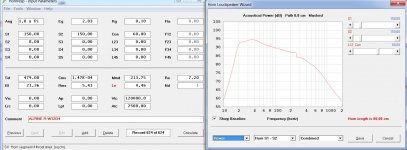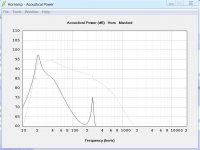Hi all,
I have a 12" DIY ported sub.
If I close the front side of the driver with another sealed chamber will it become a bandpass ???
(Assuming I estimate the front chamber volume by following regular seald sub design principles to achieve a Qtc around 0.707)
If i ask the same question differently.....
In a bandpass, can we design the front sealed chamber by following regular sealed sub design principles, and the rear ported chamber by following regular ported sub design principles ???
Thanks in advance...
Naveen
I have a 12" DIY ported sub.
If I close the front side of the driver with another sealed chamber will it become a bandpass ???
(Assuming I estimate the front chamber volume by following regular seald sub design principles to achieve a Qtc around 0.707)
If i ask the same question differently.....
In a bandpass, can we design the front sealed chamber by following regular sealed sub design principles, and the rear ported chamber by following regular ported sub design principles ???
Thanks in advance...
Naveen
Yes, it'll convert to a 4th order bandpass.
The two chambers will each affect the other (they're both applying force to the same cone, after all), so you'll need something like WinISD Pro or Hornresp to simulate what will happen.
Chris
The two chambers will each affect the other (they're both applying force to the same cone, after all), so you'll need something like WinISD Pro or Hornresp to simulate what will happen.
Chris
Here's a good link for bandpass configurations, along with a hornresp example.
The Subwoofer DIY Page - Bandpass Systems
The Subwoofer DIY Page - Bandpass Systems
In principle yes, but you still need to 'tune' the chambers differently than the ported sub. A bigger sealed chamber shifts the bandwidth to the lower side. A bigger front chamber narrows the bandwidth and increases gain and vice versa.
Pick your usable bandwidth first, arrive at the needed power( and xmax) to get the required SPL.
Pick your usable bandwidth first, arrive at the needed power( and xmax) to get the required SPL.
Typically, the closed chamber of a 4th order BP is responsible for the low end and the reflex chamber/port is used for the high end roll off. In order to make a reflex (aimed at the same band width) into a 4th order BP, the reflex part and the closed chamber need to switch their tuning to avoid a very narrow band width. In other words the reflex needs to be tuned higher (say 80 - 100 Hz).
"Converting" a well designed enclosure to another principle will in 99% of all cases give a worse result.
If you want to design any kind of loudspeaker box, first you measure the TSP parameter of the driver. Then, you take into account the maximum stroke and electical power it can take.
Now you take a simulation software and enter all values and can try it for different principles and volumes.
I do not want to be unfriendly, but any other way of "try & error" is very stupid.
This is the best answer any one can give you.
If you do not know how to measure, learn it. If you do not know how to simulate, read. Otherwise leave your speakers alone. You will not "learn" anything from modifying them, nor will anything use able be the result. Just wasted time and money.
If you want to design any kind of loudspeaker box, first you measure the TSP parameter of the driver. Then, you take into account the maximum stroke and electical power it can take.
Now you take a simulation software and enter all values and can try it for different principles and volumes.
I do not want to be unfriendly, but any other way of "try & error" is very stupid.
This is the best answer any one can give you.
If you do not know how to measure, learn it. If you do not know how to simulate, read. Otherwise leave your speakers alone. You will not "learn" anything from modifying them, nor will anything use able be the result. Just wasted time and money.
"Converting" a well designed enclosure to another principle will in 99% of all cases give a worse result.
If you want to design any kind of loudspeaker box, first you measure the TSP parameter of the driver. Then, you take into account the maximum stroke and electical power it can take.
Now you take a simulation software and enter all values and can try it for different principles and volumes.
I do not want to be unfriendly, but any other way of "try & error" is very stupid.
This is the best answer any one can give you.
If you do not know how to measure, learn it. If you do not know how to simulate, read. Otherwise leave your speakers alone. You will not "learn" anything from modifying them, nor will anything use able be the result. Just wasted time and money.
Very well said Turbowatch2 !!!
In the initial days of Diy, I began with trail and error and wasted lot of time and money. Now I design my ported subs with softwares like Winisd, Basta etc.
I was actually trying to understand if the working principle of 4th order bandpass is just a combination of sealed + ported. Now I assume its not just mix and match technique. It needs to be designed with its own principles. Thanks again !!!
I have a 12" DIY ported sub.
If I close the front side of the driver with another sealed chamber will it become a bandpass ???
Greets!
Yes, though not what's considered a good one. You need to vent the chamber over the driver and seal up the vented one unless you want 6th order.
Classic [pre -T/S] BP4 requires the new vented chamber be 1/4x new sealed chamber tuned to Fs, so at least a place to start, though expect a much longer vent and efficiency to plummet based on me trying it out in a few sims.
GM
I have a 12" DIY ported sub.
If I close the front side of the driver with another sealed chamber will it become a bandpass ???
(Assuming I estimate the front chamber volume by following regular seald sub design principles to achieve a Qtc around 0.707)
Yes, but it will be very much a "one-note" type of 4th order bandpass, which are all characterized by having a vented section that's larger than the sealed section, a
If i ask the same question differently.....
In a bandpass, can we design the front sealed chamber by following regular sealed sub design principles, and the rear ported chamber by following regular ported sub design principles ???
Nope.
Classic [pre -T/S] BP4 requires the new vented chamber be 1/4x new sealed chamber tuned to Fs..........
'Haste makes waste', 🙁 should be Fs/0.707.
GM
- Home
- Loudspeakers
- Subwoofers
- Convert a ported sub into bandpass

